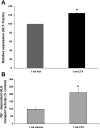GLT-1 overexpression attenuates bladder nociception and local/cross-organ sensitization of bladder nociception
- PMID: 21429971
- PMCID: PMC3119143
- DOI: 10.1152/ajprenal.00009.2011
GLT-1 overexpression attenuates bladder nociception and local/cross-organ sensitization of bladder nociception
Abstract
Glutamatergic pathways mediate transmission of pain. Strategies to reduce glutamatergic neurotransmission may have beneficial effects to mitigate nociception. Recent work revealed that overexpression of the astrocytic glutamate transporter (GLT-1) by transgenic or pharmacologic approaches produced a diminished visceral nociceptive response to colonic distension. The purpose of this study was to determine the effect of GLT-1 overexpression on the visceromotor response to bladder distension. Increased glutamate uptake activity produced by 1-wk ceftriaxone (CTX) treatment attenuated 60-64% the visceromotor response to graded bladder distension compared with vehicle-treated mice. One-hour pretreatment with selective GLT-1 antagonist dihydrokainate reversed the blunted visceromotor response to bladder distension produced by 1-wk CTX, suggesting that GLT-1 overexpression mediated the analgesic effect of CTX. Moreover, sensitization of the visceromotor response to bladder distension produced by local bladder irritation (acrolein) was also attenuated by 1-wk CTX treatment. A model of cross-organ sensitization of bladder visceromotor response to distension was next studied to determine whether increased expression of GLT-1 can mitigate colon to bladder sensitization. Intracolonic trinitrobenzene sulfonic acid (TNBS) administered 1 h before eliciting the visceromotor response to graded bladder distension produced a 75-138% increase in visceromotor response compared with animals receiving intracolonic vehicle. In marked contrast, animals treated with 1-wk CTX + intracolonic TNBS showed no enhanced visceromotor response compared with the 1-wk vehicle + intracolonic vehicle group. The study suggests that GLT-1 overexpression attenuates the visceromotor response to bladder distension and both local irritant-induced and cross-organ-sensitized visceromotor response to bladder distension.
Figures





Similar articles
-
Increased glial glutamate transporter EAAT2 expression reduces visceral nociceptive response in mice.Am J Physiol Gastrointest Liver Physiol. 2009 Jan;296(1):G129-34. doi: 10.1152/ajpgi.90556.2008. Epub 2008 Nov 20. Am J Physiol Gastrointest Liver Physiol. 2009. PMID: 19023027 Free PMC article.
-
[The impact and mechanism of glutamate transporter 1-mediated visceral nociception and hyperalgesia following exposure to post-traumatic stress disorder-like stress in spinal cord of rats].Zhonghua Nei Ke Za Zhi. 2014 Jun;53(6):477-81. Zhonghua Nei Ke Za Zhi. 2014. PMID: 25146518 Chinese.
-
Characterization of the Visceral Antinociceptive Effect of Glial Glutamate Transporter GLT-1 Upregulation by Ceftriaxone.ISRN Pain. 2012 Dec 25;2013:726891. doi: 10.1155/2013/726891. eCollection 2013. ISRN Pain. 2012. PMID: 27335870 Free PMC article.
-
Glutamate Transporter GLT-1 as a Therapeutic Target for Substance Use Disorders.CNS Neurol Disord Drug Targets. 2015;14(6):745-56. doi: 10.2174/1871527314666150529144655. CNS Neurol Disord Drug Targets. 2015. PMID: 26022265 Free PMC article. Review.
-
Do the urinary bladder and large bowel interact, in sickness or in health? ICI-RS 2011.Neurourol Urodyn. 2012 Mar;31(3):352-8. doi: 10.1002/nau.21228. Epub 2012 Feb 29. Neurourol Urodyn. 2012. PMID: 22378593 Free PMC article. Review.
Cited by
-
The Effect of GLT-1 Upregulation on Extracellular Glutamate Dynamics.Front Cell Neurosci. 2021 Mar 26;15:661412. doi: 10.3389/fncel.2021.661412. eCollection 2021. Front Cell Neurosci. 2021. PMID: 33841104 Free PMC article.
-
Stress-induced visceral pain: toward animal models of irritable-bowel syndrome and associated comorbidities.Front Psychiatry. 2015 Feb 16;6:15. doi: 10.3389/fpsyt.2015.00015. eCollection 2015. Front Psychiatry. 2015. PMID: 25762939 Free PMC article. Review.
-
Altered glial glutamate transporter expression in descending circuitry and the emergence of pain chronicity.Mol Pain. 2019 Jan-Dec;15:1744806918825044. doi: 10.1177/1744806918825044. Mol Pain. 2019. PMID: 30799685 Free PMC article.
-
Optimization of a pain model: effects of body temperature and anesthesia on bladder nociception in mice.PLoS One. 2013 Nov 5;8(11):e79617. doi: 10.1371/journal.pone.0079617. eCollection 2013. PLoS One. 2013. PMID: 24223980 Free PMC article.
-
Glutamate transporter activators as anti-nociceptive agents.Eurasian J Med. 2011 Dec;43(3):182-5. doi: 10.5152/eajm.2011.39. Eurasian J Med. 2011. PMID: 25610189 Free PMC article. Review.
References
-
- Berger UV, Hediger MA. Distribution of the glutamate transporters GLT-1 (SLC1A2) and GLAST (SLC1A3) in peripheral organs. Anat Embryol (Berl) 211: 595–606, 2006 - PubMed
Publication types
MeSH terms
Substances
Grants and funding
LinkOut - more resources
Full Text Sources
Medical
Molecular Biology Databases

